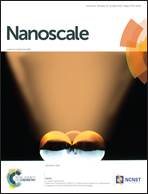Thermoelectric properties of PEDOT nanowire/PEDOT hybrids†
Abstract
Freestanding poly(3,4-ethylenedioxythiophene) (PEDOT) nanowires were synthesized by template-confined in situ polymerization, and then integrated into polystyrene sulfonate (PSS)-doped PEDOT and tosylate-doped PEDOT hosts, respectively. The hybrid morphologies were characterized by atomic force microscopy, indicating the homogeneous dispersion of PEDOT nanowires. The thermoelectric properties of the resultant hybrids were measured, and the power factor was found to be enhanced by 9-fold in comparison with PEDOT:PSS mixed with 5 vol% dimethyl sulfoxide while the low thermal conductivity was still maintained. Such a significant improvement could be attributed to the synergistic effects of interfacial energy filtering, component contributions, and changes of carrier concentrations in the host materials. Upon addition of 0.2 wt% PEDOT nanowires, the resultant composites demonstrated a power factor as high as 446.6 μW m−1 K−2 and the thermoelectric figure of merit could reach 0.44 at room temperature. The thermoelectric devices were investigated by using the PEDOT nanowire/PEDOT hybrid as a p-type leg and nitrogen-doped graphene as an n-type leg. The normalized power output was as high as ∼0.5 mW m−2 for a temperature gradient of ΔT = 10.1 °C, indicating great potential for practical applications. These findings open up a new route towards high-performance organic thermoelectric materials and devices.


 Please wait while we load your content...
Please wait while we load your content...